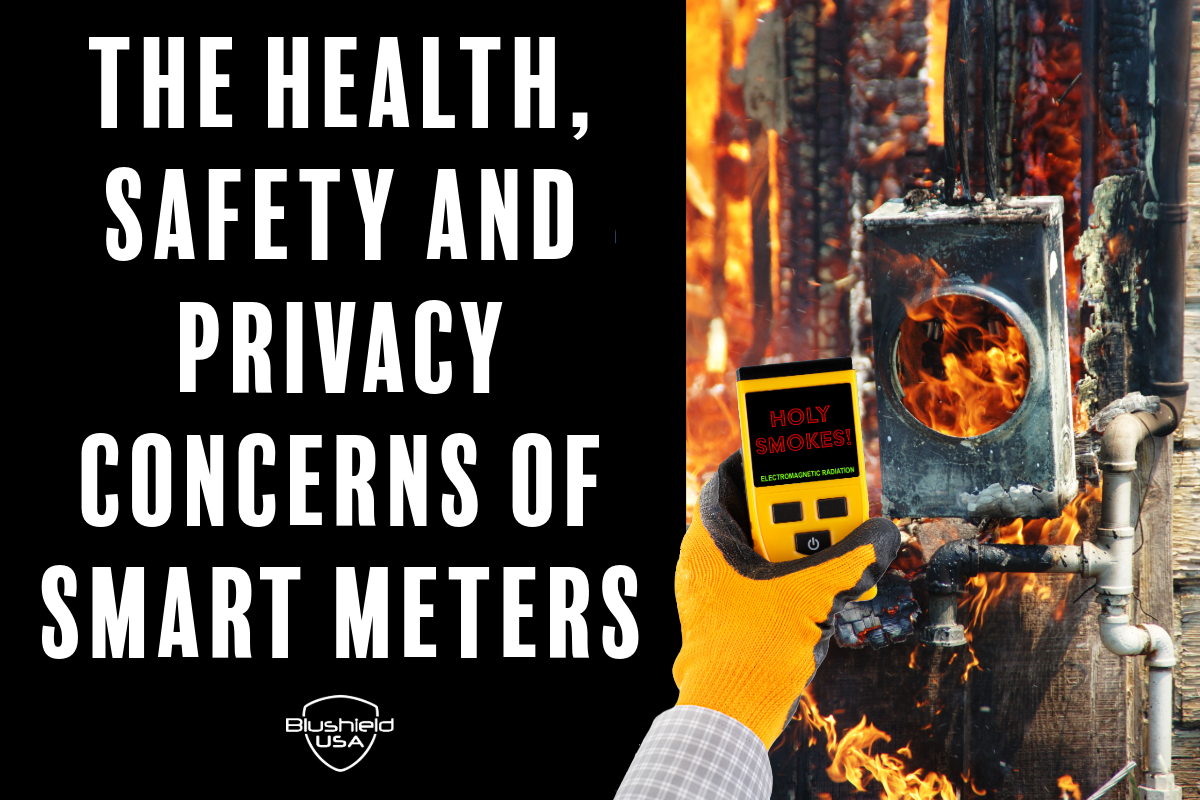
About 15 years ago, a new kind of home electric meter with special capabilities came onto the scene, promising consumers savings on their electric bills, and convenient access to information about their electricity usage. These new meters were named smart meters (technically called advanced metering infrastructure - AMI), and were considered to be an economical and functional upgrade to the digital and analog meters that were previously used on all residences and buildings. Unlike older digital and analog meters, which required being manually read once a month by a utility company employee, smart meters transmit this information wirelessly, in the form of radio frequency electromagnetic fields.
If the creators of smart meters simply allowed the 6-millisecond pulse of an information carrying radio wave to be sent from the meter on each residence to the power company once a month, to eliminate the cost of having to physically send a worker to each residence to take meter readings, they could have stopped right there and potentially avoided the myriad of problems associated with smart meters we are seeing today. However, visions of the smart grid of the future, and of automated homes, compelled them to reach much further.
Of course, just like 5G, smart meters are advertised to mainly benefit the end user, but the truth is that the user is ultimately put at risk in several ways, and the biggest benefits are reaped by the power companies and the government.
Smart meters boast the recording of “real time information on power usage”, so that the customer can monitor their own electricity usage and see the costs in real time, to adjust power usage and save money. The truth is, people’s electricity costs have uniformly gone up, not down, since the installation of smart meters. The verdict from electricity consumers after more than a decade of smart meter use is that there have been no benefits to them, and that the majority of people do not have any interest in seeing a breakdown of their energy usage. It seems that people are generally already aware of how they are using electricity, will choose to continue using electricity the same way they were before, and are more than happy to pay for it.
Besides having no significant benefits to the end user, smart meters have brought widespread concerns over health, safety and privacy.
Health concerns revolve around the pulsed radio frequency radiation that smart meters rely on to transmit wireless information between each meter and the utility company’s headquarters. This is a similar type of non-ionizing radiation used by cell phones, cell towers and Wifi routers, all of which have been extensively studied and found to be dangerous to human health. However, smart meters in particular have a unique exposure risk, due to several factors:
- close proximity to the living areas in a home (sometimes just several feet from a sleeping area)
- the sharp, spiked radio frequency pulsations used to transmit the signal
- how frequently the signal is transmitted (up to 190,000 times per day!)
- dirty electricity created by the smart meter communicating with in-home appliances
Smart meters are often installed on the outside of the wall of a main living area or bedroom, where residents spend a lot of time. In addition to the omnidirectional, pulsed radio frequency field that’s often emitted many times per minute, the meter also produces a strong magnetic field that can radiate several feet into the house. To send data to and from the power company, this sharply pulsed RF wave is often produced every 3 to 7 seconds, and even up to 190,000 times per day.
Although utility companies claim that smart meters are within FCC guidelines regarding safe levels of RF exposure, this is not true, because what is being measured is the average reading, not the peak reading. This means that the incredibly strong RF spikes you are actually exposed to are being statistically averaged down to much lower levels by factoring in every single second where there is no RF output at all. If one were to measure the strength of the actual RF spikes, they are often 200 times the strength of the documented “average”.
Daniel Hirsch, Professor of Nuclear Policy at the University of California-Santa Cruz, calculated that the whole-body cumulative radiation exposure from wireless meters is 100–150 times higher than cell phone exposure. The graph below, from Professor Hirsch’s report, shows the cumulative bodily RF exposure of smart meters (at a distance of 3 feet), compared to cell phones, microwave ovens, Wifi routers, radio/TV broadcasts, and a smart meter from a further distance.
 |
 |
This graph shows why close proximity to a smart meter can be devastating to health. Cecelia Doucette, a technology safety educator and the director of Massachusetts for Safe Technology, states that, “These meters are installed directly on our homes and elsewhere with no informed consent, and people unwittingly sleep or spend time on the other side of the wall and get very, very ill.”
However, the risks of health harm from a smart meter on your home are not negated much by staying further away from it. This is because the smart meter actually communicates with your in-home electrical appliances every couple of seconds, to record specific appliance usage. This happens through the electrical wiring of your house. The meter uses something called a switched mode power supply to change the voltage every time it moves between the meter and the electrical line, and since it does this every couple of seconds, it generates an enormous amount of what is known as “voltage transients” or “line noise”, now more popularly known as dirty electricity.
Dirty electricity is a spiky, pulsed, highly variable electrical current that rides through all the circuitry of a building, and radiates a few feet into every room, near where the electrical lines run behind the wall, as well as behind each electrical outlet. It can have devastating health effects.
Unfortunately, this means that if you are lucky and persuasive enough to convince the power company to shut off the RF signal emission to and from your smart meter, or to replace it with what’s being called an “Opt-Out meter” in some places, you are not eliminating the dirty electricity problem at all. The smart meter is still actively collecting detailed data from all your appliances; it’s just not sending it via RF to the power company anymore, so only one part of your problem is solved.
This survey and report on the health effects of smart meters compiles data from a questionnaire filled out by 201 people who claim that smart meters have damaged their health. Some of these people already considered themselves electro hypersensitive (EHS) before their smart meter was installed, but the smart meter made it much worse. Others did not consider themselves EHS before the smart meter, but state that the meter exposure has made them hypersensitive to all EMF sources, including their cell phone and computer, which many did not have issues with previously.
The report also summarizes the most common symptoms the survey participants experienced from smart meter exposure. The most commonly reported symptoms that were either new or worsened from exposure were ear ringing, headaches, difficulty concentrating, insomnia, fatigue and heart arrhythmias. 42% of the survey participants actually developed their symptoms prior to the knowledge of the presence of smart meters, and before they had any awareness of RF radiation danger, which rules out psychosomatic factors.
Safety and privacy issues of smart meters
These high-tech meters are not just a risk to your health, they also come with safety and privacy issues. They have become notorious for exploding and causing house fires. EMF electrical consultant Cindy Sage explains that smart meters can create an over-current condition on the wiring and produce heat that the neutral cannot properly handle, which can lead to fires. This stress on the wiring is caused by the short, intense bursts of very high intensity radio frequency emissions, which can spike the voltage too high.
Other potential causes of smart meter explosions are incompatibilities between the old meter base and the new meter, loose connections, and defective equipment. So far, hundreds of thousands of meters have been replaced either because of an actual explosion or fire caused by the meter, or meters that were suspected to be defective and potentially unsafe. In 2015 in Stockton, California, a truck crashed into a utility pole, which caused a power surge that resulted in about 50-60 smart meters exploding and catching on fire at residential homes. Although power companies publicly deny that smart meters carry a risk of explosion and fires, they have installed voltage and heat sensors on the meters as a precautionary measure, for monitoring purposes. Actions speak louder than words.
Another major issue with smart meters is related to privacy and security. The meters collect extremely detailed data about your in-home electricity usage, including which appliances are used, how often, and when. Then this data is transmitted wirelessly, and wireless data is much easier to intercept and hack than a secure wired connection. This means that anyone with some tech know-how and bad intentions can discover what you’re doing and when you’re doing it, and may be able to use that information to harm you.
Also, it’s becoming widely known that utility providers can collect and sell your power usage data to third-party companies, as long as they withhold identifiable personal information like your name and social security number from these companies. Of course, they tell you this is for your benefit, so that they can “serve you better”. They make a lot of money selling this information, so it makes sense that we should be seeing considerable reductions in our electricity bills if we have smart meters, since the utility providers are making money from our personal usage data. Then why have electricity costs only gone up?
One of the most concerning aspects of the two-way data transmission of smart meters is the fact that our meters are now remotely controlled from the utility headquarters. This means they can turn our power off anytime, for any reason they deem necessary. If we miss our bill payment due date, they can shut off our power instantly right from the source, instead of having to send a service technician to our house to do it manually. They also have the power to control our usage, and it’s not unrealistic to imagine a so-called energy crisis moment where they decide that it’s best for the collective that our thermostats stay within a narrower range on an exceptionally cold or hot day, when the power grid is extra busy.
Can you get rid of your smart meter?
Utility companies have been busy for more than a decade replacing as many older analog and digital meters with smart meters as possible, so chances are high that you currently have a smart meter installed on your house. Can you get rid of it? If so, how do you do this, and what are the potential downsides and complications of doing so?
It depends on where you live. Since the initial rollout of smart meters, due to widespread opposition from individuals, several states have enacted statewide opt-out policies. Other states have unique policies, or case-by-case opt-out programs. State legislatures are being confronted with this issue more and more frequently, so even more opt-out policies are being considered.
You can look up the details of the smart meter opt-out policies of your state here:https://www.ncsl.org/energy/smart-meter-opt-out-policies
Unfortunately, most states that do allow opt-outs charge a one-time fee, as well as a monthly fee, to complain that you not having a smart meter is inconvenient for them. The fees vary considerably by state, ranging from single digit monthly fees to hundreds of dollars in one-time fees. Iowa now allows residents to opt-out and keep their analog meters at no charge.
New Hampshire, as usual, sets the precedent as the state to look up to: not only is there no charge to keep your old meter, but they actually have an ‘opt-in’ policy instead of opt-out, where utility companies must obtain written consent before they can install a smart meter on a home or business.
Pennsylvania, however, has a statewide requirement that utility companies deploy smart meters across their entire service area, and customers are not allowed to opt out for any reason.
The main issues with these fees concerns electro hypersensitive (EHS) individuals, and the considerable threat that smart meters pose to their health, functionality and well being. Ed Friedman, a Maine resident who filed a disability/discrimination lawsuit against a Maine power company for not agreeing to waive fees to accommodate his disability, states that his doctor recommends that he should not be exposed to any RF radiation in his home. The Americans with Disabilities Act (ADA) prohibits discrimination against people with disabilities from accessing government programs and services. Because of his debilitating sensitivity to RF radiation, he is being forced to pay monthly fees to use an analog electric meter that doesn’t aggravate his condition. Disabled people often have budget constraints, because they are often not able to work, so these monthly fees can be the breaking point for many of them.
Children’s Health Defense has been working towards establishing more freedom of choice when it comes to smart meter exposure. They wrote up a template letter that you can easily send to your state legislators in support of utility meter choice, and are urging everyone concerned about this issue to take this simple step towards more awareness and choice:
Tell Your State Legislators to Introduce/Support Utility Meter Choice
Some states, like Texas, allow you to request to have two-way meter communication turned off, which will solve the issue of RF radiation exposure, and will minimize the privacy and security concerns of wireless data transmission. However, as mentioned earlier, it may not affect dirty electricity exposure or meter safety issues at all.
The Smart Meter Education Network is an excellent resource for Michigan residents, but also has information that should be very useful for anyone wanting to learn more about the dangers of smart meters, and how to replace yours with a safer alternative.
Can you protect yourself from smart meter radiation?
If you currently have a smart meter, and are not able to get rid of it because of the expense involved, or limitations in your state laws, are there ways to protect yourself from its harmful radio frequency radiation and dirty electricity?
Yes! There are a few things you can do. First, make sure your smart meter is as far as possible from your main living area, and especially your bed. If your bed is on the opposite wall of your smart meter, it would be a good idea to move it somewhere else. Some people like to use a metal mesh smart meter cover to create a Faraday cage around their meter, which will block most of the measurable RF radiation emitted by the meter, but will still allow enough signal to get through to send data to the power company. You could also use dirty electricity filters on your home electrical outlets to reduce the intensity of the line noise/voltage transients caused by the meter.
Those options will likely offer some relief by reducing exposure, but if you have a smart meter on your home, we strongly recommend that you use an appropriate strength home Blushield device, which will create a stronger, biologically coherent scalar field that protects your body at the cell level. This is an effective way to internally mitigate any EMFs that are not possible or practical to remove from your space. The chaotic, stressful field produced by the smart meter’s pulsed RF, magnetic field and dirty electricity can trigger the body to mount an immune response, like it’s attacking an invader that’s never defeated. Adding a Blushield field to that space acts like a bubble of protection for your cells, calming the overactive immune response and surrounding you with a nature-based frequency field.
The home Blushield device you choose should depend on your overall EMF exposure, considering all sources like smart meters (yours and your neighbors’), Wifi routers, cell phones, smart devices, nearby cell towers, dirty electricity and more. For a straightforward and easy way to determine the best home and portable Blushield models for your needs, please read our Blushield Product Guide.
References:
- Smart Meter Education Network: Health – https://www.smartmetereducationnetwork.com/smart-meter-health-effects.php
- Smart Meter Education Network: Dirty Electricity – https://www.smartmetereducationnetwork.com/dirty-electricity-and-smart-meters.php
- Comments on the Draft Report by the California Council on Science and Technology: “Health Impacts of Radio Frequency from Smart Meters” by Daniel Hirsch1 – https://www.committeetobridgethegap.org/pdf/110212_RFrad_comments.pdf
- Smart Meter Health Effects Survey and Report – https://www.mainecoalitiontostopsmartmeters.org/wp-content/uploads/2013/01/Exhibit-10-Smart-Meter-Health-Effects-Report-Survey2.pdf
- The Foundation for Information Policy Research: Smart Meters – https://web.archive.org/web/20160313055246/http://www.fipr.org/100110smartmeters.pdf
- Summary of Evidence on Smart Meter Fires – http://emfsafetynetwork.org/wp-content/uploads/2016/01/Summary-of-Evidence-on-Smart-Meter-Fires.pdf
- The Defender: “Why Smart Meters Are Good for Utility Companies, Bad for Consumers” – https://childrenshealthdefense.org/defender/smart-meters-health-privacy/
- National Conference of State Legislators: Smart Meter Opt-Out Policies – https://www.ncsl.org/energy/smart-meter-opt-out-policies

